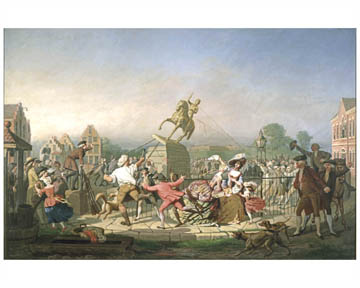William Walcutt: “Pulling Down the Statue of George III at Bowling Green, N.Y. July 9, 1776.”

William Walcutt, Pulling Down the Statue of George III at Bowling Green, July 9, 1776. 1857, oil on canvas,51-5/8 x 77-5/8 inches, Lafayette College Art Collection.
The statue of King George III by British sculptor Joseph Wilton was dedicated August 16, 1770, at Bowling Green, at the southern tip of Manhattan.
William Walcutt’s 1857 painting depicts the destruction of the monument by New Yorkers and George Washington’s troops following a public reading of the Declaration of Independence on July 9, 1776.
On the evening of July 9, 1776, after news reached New York of the approval by the Second Continental Congress of the Declaration of Independence, a mob toppled the statue of the British king George III in an act of “symbolic regicide.” According to legend, the pieces of the statue were then sent to Connecticut, where they were melted down and made into 40,000 bullets for the Continental Army. The nationalism inherent in this incident was of great interest to mid-19th-century, pre-Civil War artists, including Walcutt, whose depictions of events related to the 18th-century establishment of the Union served as encouragement in the mid-19th century for its salvation.
A native of Columbus, Ohio, William W. Walcutt (1819-1882) studied painting and sculpture in New York and in Europe. In addition to his success as a history painter, he is known for his lifesized marble statue of Commodore Oliver Hazard Perry, which was commissioned to commemorate Perry’s decisive victory at the September 10, 1813, Battle of Lake Erie, during the War of 1812. It was originally installed in Cleveland, Ohio, in 1860.
For additional information
- see exhibition catalogue for Art Under Attack, Histories of British Iconoclasm, edited by Tabitha Barber and Stacy Boldrick, published by Tate Britain 2013.
- After protesters toppled statues of Confederate soldiers, Kelly Grovier looked at how the images have echoes in the 18th Century. “When is it OK to pull down statues,” August 17, 2017
- Andy Lawler, July 1, 2020, “Pulling down statues? It’s a tradition that dates back to U.S. independence.” NationalGeographic.com, July 1, 2020
- Johannes Adam Simon Oertel depicted the same event several years earlier (1852-53) than did Walcutt (1857). An extensive description of the Oertel version can be found at the New-York Historical Society website.
- Wendy Bellion, discusses the destruction of the statue of George III in Iconoclasm in New York: Revolution to Reenactment, and “…demonstrates how British monuments gave rise to an American creation story.” University Park, Pa: Penn State University Press, 2019.
- Wendy J. Katz, Humbug! The Politics of Art Criticism in New York City’s Penny Press, New York: Fordham University Press, 2020
- “One Hundred Years Ago: A day of rejoicing in New-York. Washington reading the Declaration of Independence–Wild enthusiasm of the people–hauling down the statue of George III–interesting reminiscences of the period.” New York Times Archives, print edition July 9, 1876.
- David W. Dunlap, “Long-toppled statue of King George III to ride again, from a Brooklyn studio,” October 20, 2016. New York Times